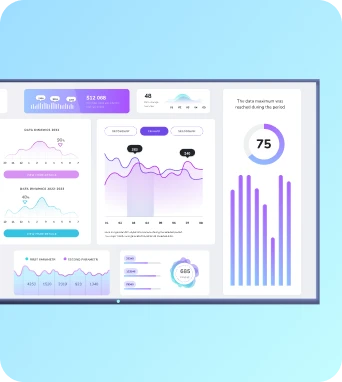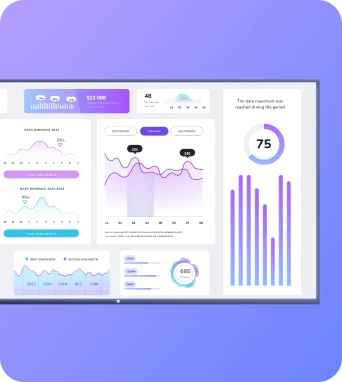An SEO dashboard should be like a cheat sheet for your business — not a Where’s Waldo search-and-find. 👀 But all too often, these tools are crammed with unnecessary KPIs, or they're missing key metrics that might otherwise give you a boost.
The good news is that all this is avoidable, provided you can sort the must-haves from the no-needs.
In this guide, you’ll learn how to build an efficient SEO dashboard with genuinely useful KPIs, metrics, and reporting features.
What in the world are SEO dashboards?
An SEO dashboard is a centralized platform that lets everyone on your team track key SEO metrics and data in one place. That way, they can track ongoing SEO efforts, make decisions to improve SEO strategies, and ultimately track whether or not the business (or the client) is engaging in effective search engine optimization.
SEO dashboards are basically the North Star for any business or SEO agency wanting to monitor and analyze their website’s SEO performance. That said, they won’t always look the same.
For example:
- Executives might just want the high-level details
- SEOs might be looking for ultra-specific info
- Clients might be curious about metrics they understand in plain English.
We'll talk about that later on in the guide.
The many benefits of using an SEO dashboard
So, unless you don’t have a website at all, there’s no reason not to use an SEO dashboard.
For starters, it’s one of the easiest ways to pull multiple ‘threads’ of data into one big dashboard ‘sweater.’ That way, you can combine everything you should know about your SEO — keyword rankings, organic search traffic, conversion rates, and more — all on the same screen. No more digging through six different logins or tabbing between tools to track down details.
Having this data at your fingertips lets you quickly spot problems (like slipping keyword positions), double down on what’s working (like that blog post suddenly pulling in traffic), and keep your strategy aligned with SEO trends and best practices.
SEO dashboards are also great collaboration tools. Instead of sending yet another Google Sheet or exporting yet another report, you can hand over a link to a shared, always-up-to-date dashboard that’s constantly tracking your SEO performance.
Best of all, you never have to rebuild a report from scratch whenever you want an update. Your SEO dashboard keeps the most important metrics front and center, so you can focus less on gathering data and more on making decisions.
How to set up an SEO dashboard
Now that we’ve covered the particulars of SEO dashboards, let’s dive into setting one up.
There are five steps to follow:
1. Sketch Out Your Goals
What do you actually want out of your dashboard? To share information? To monitor progress?
Take some time to write down the particulars, then brainstorm any components you might need to bring it to life.
2. Think About KPIs
These can quite literally make or break your SEO dashboard, so you’ll want to get things right the first time.
We cover some mission-critical options later in the guide.
For now, you just need to know what to avoid up-front:
- Vanity metrics. Basically anything that looks good on paper, but doesn’t really speak to the SEO campaign at hand.
- Things you can’t necessarily control. This includes stuff like average session duration, bounces rate, and exit rates.
- Super granular numbers in isolation. Do you really need to see a breakdown of web traffic by page? Or are the top three pages enough for your use case?
💡Related: Metrics vs KPIs: What's the Difference and Why it Matters
3. Get building
This is where the rubber really meets the road — er, where the KPIs hit the big screen.
Now it’s time to create your dashboard (or a series of dashboards) where your KPIs should live.
You have two different options:
Choose a template
Don’t feel like building completely from scratch?
You can always rely on some SEO dashboard templates.
For example, you might:
- Use a Looker Studio template. It’s a fairly convenient and efficient way to create custom SEO dashboards.
- Grab something from Databox. Databox offers a range of pre-built metrics and visualizations, including keyword rankings, organic traffic, and conversion rates.
- Consider Google Data Studio. This is currently available through the Google Cloud system, but past users complain it's dated at best.
You should know that SEO dashboard templates aren’t always as useful as they seem. If you need to track complex metrics, for example, or if you don’t want to pay for pricey user licenses, you’re better off creating a custom dashboard.
Which leads to our next point…
Create a custom SEO dashboard
If a good ol’ fashioned Looker Studio template doesn’t really match your stride, you might want to consider building a custom dashboard design with specific metrics, colors, and designs.
Just know this isn’t the simplest path — and you may need an analyst to help you navigate next steps. But that doesn’t mean it’s entirely undoable.
Here are a couple quick pointers on effective dashboard creation:
- These dashboards can be tailored to meet specific business needs and goals, including tracking keyword rankings, organic traffic, and conversion rates.
- Custom dashboards provide a flexible and scalable solution for SEO reporting and analysis.
- They enable users to focus on the most important metrics and KPIs for their business.
4. Hook up third-party integrations
Depending on your setup, you might want to connect with:
- Google Analytics (GA): Integrating Google Analytics with your SEO dashboard can help you track website traffic, behavior, and conversion rates.
- Google Search Console (GSC): You might connect your GSC account to keep tabs on your performance in search results. Unlike GA, which only monitors your website, GSC tracks how well your website performs in search results.
- Ahrefs: This can be customized to include specific website details, like domain rankings, competitor content, AI overview rankings, and more.
You can check out a complete list of digital signage integrations here.
5. Perform regular SEO dashboard maintenance
It may not be fun, but it does need to get done. If you pardon the rhyme.
That’s because SEO dashboard maintenance is critical to ensuring accuracy and relevance. If you don’t clean up your data, you might be forced to make some pretty not-so-accurate decisions later.
By maintenance, I mean updating your SEO dashboard anytime you’re:
- Tracking new keywords
- Updating metrics
- Or even adjusting the dashboard layout
Of course, you can skip 95% of the maintenance process by just creating a TV dashboard with a partner like Fugo. 😏
Examples of SEO dashboards by use case
You can put your SEO dashboard to work in a few different ways, depending on your department, business, or business angle.
Here are a few examples to get the creative juices flowing:
For in-house teams: Content tracking for keyword rankings
If you’re a startup or scaleup, you’re likely building all your web content from scratch. So you might want to create an SEO dashboard that tracks your highest-performing content based on keyword volume and traffic.
Maybe you notice that your keyword rankings show how visible and relevant your website is for specific search queries, like ‘orange hair ties’ or ‘CRM for small businesses.’ This can help you identify areas for improvement and optimize your SEO strategy based on what users are actually searching for.
For reporting to executives: Monitoring website analytics
An analytics dashboard can help executive teams sort through SEO metrics without slogging through endless numbers or less-important details.
For example, you might create a dashboard just for senior execs that’s integrated with platforms like Google Analytics. Or maybe you connect your AI dashboard builders to your Google Search Console and collect specific GSC data.
That way, you only highlight the details they need to know on a regular basis, like total website visitors, content value, or conversion value.
For clients: Optimizing Google searches
You already know how important Google search optimization is — it helps websites rank higher in search engine results pages (SERPs). But as an SEO agency, your clients may not know that. So you’ll need to build a dashboard that helps them better understand what you're up to.
SEO dashboards can be customized to track Google search metrics, including keyword rankings, organic traffic, and conversion rates. You might leave little notes explaining what each metric means, like how optimizing for searches will improve online visibility and drive more traffic to the client’s website.
For marketing agencies: Building a marketing dashboard
A marketing dashboard is a comprehensive overview of key marketing metrics and data that can help you make better decisions about outreach. This makes sense whether you’re running a marketing agency, operate an in-house team, or are a CMO (Chief Marketing Officer).
For example, you might integrate your dashboard with common marketing tools, such as social media and email marketing platforms, to get a more holistic view of your performance. You can also create dashboards to collaborate with other teams, like tracking marketing qualified leads (MQLs) versus sales qualified leads (SQLs).
What to include in a useful SEO dashboard
So now you know how to build an SEO reporting dashboard. But what in the world do you actually put on it?!
The short answer is, whatever makes the most sense for your business.
The longer answer is, at least a few of the recommended options below.
💡Sidenote: Keep in mind you may not need every metric listed. Your business will probably have different needs depending on its industry, growth trajectory, age, size, and current campaigns. So TL;DR: your mileage may vary.
Traffic generated
This should answer questions like:
- How much traffic are you getting per day or per month?
- Has there been a notable increase in organic search traffic?
- And which asset is responsible for doing all that work?
Conversion rates
Let’s say you’re running an SEO campaign trying to get more inbound leads. You might be A/B testing two different landing pages, so you want to keep tabs on which page is performing better and why.
Or maybe you just want to analyze which pages do the most heavy lifting, and which URLs might need extra support.
Top performing pages
This might be landing pages, blog posts, or any other page on your website. Anything that drives the greatest amount of interest and appeal for your brand.
When added to a dashboard, you can easily see what users are looking for, track particular pages that are driving traffic to your website, and determine top-performing pages for your team to zero-in on.
Domain authority (DA)
So this isn’t technically a Google-approved SEO metric, but it can help you get a better idea of where your website stands. The higher your score, the more likely you are to rank up top, and the less likely competitors are to beat you in the search results.
So if you notice major drops in your score or other data points trending downwards, you can jump into full reports to browse more detailed insights.
Page errors
Exactly as the title implies, page errors can help track the number of issues your website may be experiencing at a given moment. This might be 404 or redirect errors, for example, or orphan pages that need an inbound link.
You might want to add a ‘page errors dial’ to at least one slide of your SEO dashboard. That way, you can get a birds-eye view of your website’s performance and swoop in to fix problems without running lengthy reports.
Number of backlinks
Backlinks can help boost your website’s domain authority score, which in turn boosts its visibility and its likelihood to rank higher on search engines.
Knowing how many backlinks you have can help you run a competitor analysis, check out referring domains, and build better relationships with partners. It can also help track organic SEO performance, which leads into our next point…
Top converting keywords
This helps you keep tabs on organic search results to better understand what potential clients are searching for (and ultimately buying).
For example, you might notice searchers hunting for ‘toys for small dogs’ end up buying more than those who search just ‘pet toys,’ so you might adjust your website or create marketing collateral to match.
💡Sidenote: Thinking about tracking a few other specific metrics? Check out our guide to The 11 Most Useful SaaS KPIs (And How To Actually Use Them).
The dos and don’ts of SEO analytics dashboards
Like any other dashboard you create for your business, you need to know the right ‘recipe’ so you don’t accidentally make mush (and/or set the oven on fire).
So what best practices should you follow, and what mistakes should you avoid?
Let’s break it down in this handy-dandy chart:
Now, let’s take a look in greater detail.
Best Practices for SEO Dashboards
Here’s the low-down of what you should be doing with your SEO reporting dashboard:
- Track the right metrics: Prioritize KPIs like keyword rankings, organic traffic, and conversion rates so you’re measuring what actually matters.
- Customize to your business goals: A SaaS company’s dashboard will (and should) look very different from an eCommerce store. Don’t feel like you need every metric under the sun; adjust and customize accordingly.
- Keep it holistic: Make sure your dashboard tells the full story of your efforts — think on-page versus off-page performance, technical SEO, and local SEO (if applicable).
- Update SEO metrics regularly: Make sure to book time for refreshing your SEO analytics dashboard so your team isn’t making decisions based on outdated visuals. One easy way to do this is with Fugo’s TV dashboards: it automatically snapshots fresh data from your BI tool and pushes it to your screen so you always display up-to-date data.
Common SEO Dashboard Mistakes
While you’re working on building that oh-so-optimized dashboard, be sure to stay clear of these all-too-common pitfalls
- Tracking too many metrics: More isn’t always better, even if it’s data. Make sure you’re only including the most important SEO metrics on your dashboard, or at least separating different metrics into different categories. If it’s not actionable at all, or if it’s just a vanity metric, you might want to consider cutting it altogether.
- Ignoring customization: Not hating on pre-built templates here, but unless you do some tinkering, they might not necessarily fit your specific use case. One-size-fits-all is sometimes one-size-fits-none, so be sure to do a little customization so the metrics on screen fit your actual strategy.
- Neglecting maintenance: Outdated dashboards can give a false sense of security and lead to costly missteps (and unnecessary heart attacks) along the way. If you don’t have a TV dashboard from Fugo that automatically refreshes data, you’ll need to assign a specific person to review your dashboard, validate the source data, and otherwise make sure everything stays hunky-dory.
- Overcomplicating the view. If your SEO reporting dashboard looks like an airplane cockpit, most people will (wisely) stay clear. The simpler solution is to keep it clean and, well, clear, with only a few key metrics per dashboard. You can always create playlists of content in Fugo to house multiple dashboards in a single group. That way, you can give each metric its very own slide, then rotate them automatically based on the time you set.
Pssst — wanna dig a little deeper into the dos and don’ts? Check out our guide to 5 Common KPI Board Mistakes.
Why SEO dashboards should be easier to build and share
Your SEO efforts affect a whole lot more than just your website rankings. And if you want to get it right, you need an SEO dashboard tool that actually pulls its weight.
Unfortunately, most of the dashboard tools we have these days are a little, well, rigid (looking at you, Databox and Looker). It’s not always easy to pick and choose metrics, update dashboards with relevant details, or display data for everyone on your team without upgrading.
But the times are a-changin’, and rapidly so. For many growing businesses, there are better options for building dashboards that can save time, money, and effort for your teams.
We’re talking:
- Natural-language dashboard generation so you can instantly create dashboards by just asking your AI agent for help.
- Securely screen-sharing your dashboards online, on TVs, on via company intranets.
- Trigger-based automations that instantly publish content whenever you hit an SEO milestone (like reaching one million visits or closing a new lead from a landing page).
Fugo’s got some pretty exciting updates in the works, and over the next couple of months, we plan on changing the world of data dashboards entirely.
Aaaand, we can’t talk about it yet. It’s coming soon, we promise.
But you can always join our AI Beta Program for free if you want to see (and test) what we’re building behind the scenes. 😉
Frequently asked questions about SEO dashboards
Q: What is an SEO dashboard?
SEO dashboards collect all your important search engine optimization metrics in one place, like keyword rankings, organic traffic, backlinks, and conversions. That way, they’re all neatly visualized on a playlist or TV screen so you can make fast, informed decisions without drowning in spreadsheet data.
Q: What does SEO mean?
SEO stands for Search Engine Optimization. Translated from ‘jargonese,’ it’s the process of making your website irresistible to search engines like Google so it shows up higher in search results (SERPs).
The better your SEO, the more likely your ideal audience can find you, and the faster you can close deals before your competitors.
Q: What are the 4 types of SEO dashboards?
Across industries, most SEO dashboards fall into these four categories:
- Operational: Tracks here-and-now metrics, like live traffic or active campaigns
- Strategic: Gives you a big-picture view of performance over time
- Analytical: Lets you dig deep into trends and root causes
- Tactical: Bridges the gap between strategy and daily operations with mid-term metrics
Q: What are the 4 types of SEO?
First, there’s on-page SEO, which refers to everything you do on your website (keywords, content structure, etc). Next is off-page SEO, which refers to SEO tasks outside of your website that help boost credibility, including backlink building.
Third up is technical SEO, or those behind-the-scenes tweaks that help search engines crawl and index your site. Finally, you have local SEO: any optimization that puts you on the map (literally) for local searches.






